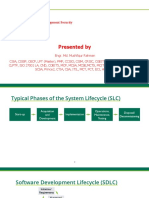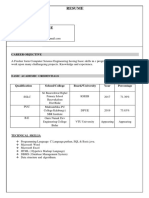CC2 - Computer Programming 1 (OverView)
Uploaded by
alhadisarip13CC2 - Computer Programming 1 (OverView)
Uploaded by
alhadisarip13Overview of programming and software development
Programming and software development involve creating software applications by writing code, testing,
and maintaining it. It’s a structured process that transforms an idea into a functional software product.
Here’s an overview:
1. Programming Concepts
- Programming Languages: Tools that developers use to write software. Each language
has its syntax, rules, and features, suited to different types of tasks. Examples include:
- Low-Level Languages: Close to machine code, such as Assembly.
- High-Level Languages: More abstract and human-readable, such as Python, Java,
C++, and JavaScript.
- Code: The set of instructions written in a programming language that a computer
can execute.
- Algorithms: Step-by-step procedures or formulas for solving a problem. Good
algorithms are efficient and solve problems in minimal time and space.
- Data Structures: Organized ways to store and manage data, such as arrays, lists,
stacks, queues, trees, and graphs.
- Debugging: The process of finding and fixing errors (bugs) in the code. Tools like
debuggers and logging help in this process.
2. Software Development Life Cycle (SDLC)
- Requirements Analysis: Understanding what the software needs to do. This involves
gathering requirements from stakeholders and documenting them.
- Design: Planning the architecture of the software. This includes designing the
software's structure, user interface, databases, and other components.
- Implementation (Coding): Writing the code based on the design specifications. This
phase involves programming the individual components of the software.
- Testing: Ensuring the software works as intended. Testing can be done at various
levels:
- Unit Testing: Testing individual components or functions.
- Integration Testing: Testing the interaction between components.
- System Testing: Testing the entire system as a whole.
- User Acceptance Testing (UAT): Testing by the end-users to ensure the software
meets their needs.
- Deployment: Releasing the software to the users. This could be in a production
environment where the software is fully operational.
- Maintenance: Ongoing support and updates to fix bugs, add new features, or
improve performance.
3. Software Development Methodologies
- Waterfall Model: A linear, sequential approach where each phase must be
completed before moving on to the next. It’s simple but inflexible, making it hard to go back to
previous stages.
- Agile Development: A flexible, iterative approach that focuses on collaboration,
customer feedback, and small, rapid releases. Agile includes frameworks like Scrum and Kanban.
- DevOps: A practice that combines software development (Dev) and IT operations
(Ops) to improve collaboration and streamline the software release process. It emphasizes
automation, continuous integration, and continuous delivery (CI/CD).
- Lean Software Development: Focuses on delivering value to the customer with
minimal waste, inspired by lean manufacturing principles.
- Rapid Application Development (RAD): Emphasizes quick prototyping and iterative
development with user feedback.
4. Programming Paradigms
- Procedural Programming: Based on a sequence of procedures or routines. It’s
straightforward and includes languages like C and Pascal.
- Object-Oriented Programming (OOP): Organizes code into objects, which represent
real-world entities. Key concepts include:
- Encapsulation: Bundling data and methods that operate on the data within one
unit (object).
- Inheritance: Allowing new objects to inherit properties and behaviors from
existing ones.
- Polymorphism: Allowing objects to be treated as instances of their parent class.
- Abstraction: Hiding complex implementation details and showing only the
necessary features.
- Functional Programming: Treats computation as the evaluation of mathematical
functions and avoids changing state or mutable data. Examples include Haskell, Scala, and F .
- Declarative Programming: Focuses on what the program should accomplish rather
than how to accomplish it. Examples include SQL for database queries and HTML for web page
structure.
5. Software Development Tools
- Integrated Development Environments (IDEs): Software that provides comprehensive
facilities for software development, such as writing, testing, and debugging code. Examples
include Visual Studio, Eclipse, and IntelliJ IDEA.
- Version Control Systems (VCS): Tools that help developers track and manage
changes to code. They support collaboration and allow developers to revert to previous versions.
Examples include Git (with GitHub or GitLab) and Subversion (SVN).
- Build Tools: Automate the process of compiling code, linking libraries, and packaging
the software. Examples include Maven, Gradle, and Make.
- Continuous Integration/Continuous Deployment (CI/CD) Tools: Automate the process
of integrating changes to the codebase and deploying them. Jenkins, Travis CI, and CircleCI are
popular CI/CD tools.
- Testing Frameworks: Tools that facilitate automated testing, such as JUnit for Java,
PyTest for Python, and Selenium for web applications.
6. Software Architecture
- Monolithic Architecture: A traditional architecture where all components of the
software are tightly integrated into a single unit. This can be simpler but harder to scale and
maintain.
- Microservices Architecture: A modern approach where the software is broken down
into small, independent services that can be developed, deployed, and scaled individually. Each
service handles a specific function and communicates with others via APIs.
- Client-Server Architecture: A model where the client (e.g., a user’s computer)
requests services from the server (e.g., a remote computer hosting a website or database).
- Layered Architecture: Software is organized into layers, each providing services to
the layer above it. Common layers include the presentation layer, business logic layer, and data
access layer.
7. Security in Software Development
- Secure Coding Practices: Writing code that is free from vulnerabilities, such as SQL
injection, cross-site scripting (XSS), and buffer overflows.
- Authentication and Authorization: Ensuring that users are who they claim to be
(authentication) and have permission to access certain resources (authorization).
- Encryption: Protecting data in transit and at rest using encryption algorithms.
- Penetration Testing: Simulating attacks to identify security weaknesses in software.
- Security Testing: Ensuring that software meets security requirements and can
protect against threats.
8. Software Maintenance and Evolution
- Bug Fixes: Identifying and resolving defects in the software.
- Feature Enhancements: Adding new functionality or improving existing features
based on user feedback.
- Refactoring: Improving the internal structure of the code without changing its
external behavior to make it easier to understand, maintain, and extend.
- Software Updates: Regularly updating software to fix bugs, patch security
vulnerabilities, and add new features.
9. Open Source vs. Proprietary Software
- Open Source Software: Software whose source code is available to the public for
use, modification, and distribution. Examples include Linux, Apache, and MySQL.
- Proprietary Software: Software that is owned by an individual or a company, with
restricted access to its source code. Examples include Microsoft Windows, Adobe Photoshop, and
Oracle Database.
10. Emerging Trends in Software Development
- Artificial Intelligence (AI) and Machine Learning (ML): Integrating AI and ML into
software to create intelligent applications that can learn and adapt over time.
- Blockchain: Decentralized technology for secure, transparent, and immutable record-
keeping, often used in cryptocurrencies and smart contracts.
- Internet of Things (IoT): Developing software that enables everyday devices to
connect to the internet and communicate with each other.
- DevSecOps: Integrating security practices into the DevOps process to ensure that
software is secure throughout its development and deployment.
This overview covers the key aspects of programming and software development, highlighting the
processes, tools, and methodologies used to create robust, scalable, and secure software
applications.
You might also like
- CodeBeamer ALM Agile Software Development GuideNo ratings yetCodeBeamer ALM Agile Software Development Guide17 pages
- Instructions + Data Structures + DocumentsNo ratings yetInstructions + Data Structures + Documents50 pages
- SOFTWARE ENGINEERING_39072811_2025_01_23_16_04No ratings yetSOFTWARE ENGINEERING_39072811_2025_01_23_16_0430 pages
- General Principle of Software Engineering PracticesNo ratings yetGeneral Principle of Software Engineering Practices1 page
- Types of Software Engineering PracticesNo ratings yetTypes of Software Engineering Practices25 pages
- Module 01) Introduction To Software Engineering and Process Models ModuleNo ratings yetModule 01) Introduction To Software Engineering and Process Models Module25 pages
- Unit 1 3 Software Processes in Software EngineeringNo ratings yetUnit 1 3 Software Processes in Software Engineering7 pages
- CC 35 Overview of Application DevelopmentNo ratings yetCC 35 Overview of Application Development4 pages
- Software Testing Interview Questions You'll Most Likely Be AskedFrom EverandSoftware Testing Interview Questions You'll Most Likely Be AskedNo ratings yet
- Using Sublime Text As A Script Editor - Unify Community WikiNo ratings yetUsing Sublime Text As A Script Editor - Unify Community Wiki6 pages
- Cartões - SAFe 6.0 Scrum Master Practice Test - QuizletNo ratings yetCartões - SAFe 6.0 Scrum Master Practice Test - Quizlet4 pages
- Madhav Institute of Technology & Science, Gwalior Deemed UniversityNo ratings yetMadhav Institute of Technology & Science, Gwalior Deemed University7 pages
- Programming in Java - - Unit 7 - Week 4 _No ratings yetProgramming in Java - - Unit 7 - Week 4 _5 pages
- Karina Nayyar - Senior Tester 8+ Years ExperiencedNo ratings yetKarina Nayyar - Senior Tester 8+ Years Experienced2 pages
- Which of The Following Is Not A Test TypeNo ratings yetWhich of The Following Is Not A Test Type3 pages
- MERN Stack Technologies Used For Web DevelopmentNo ratings yetMERN Stack Technologies Used For Web Development10 pages

























































































